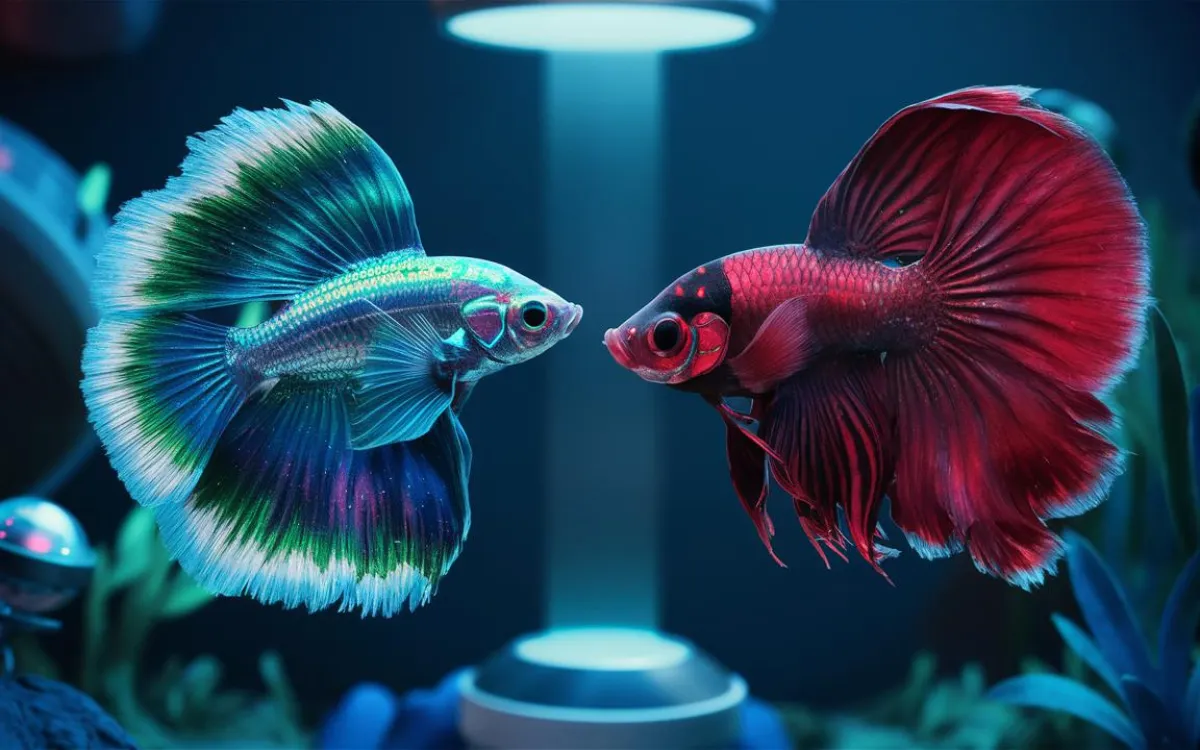Curious about your betta’s gender? This guide will help you identify the key differences between males and females, so you can confidently determine who’s who.
Betta Fish Information will cover everything from color and fin size to body shape and egg spots. Ready to unlock the secrets of your Alien Betta fish? Let’s dive in!
How to Determine Alien Betta Fish Gender

Body Shape
Generally, females are slightly shorter and more rounded in body shape compared to males. Males tend to have a more elongated and slightly flattened body, giving them a more streamlined appearance.
Color
Males tend to exhibit more vibrant and intense colors than females. This is especially true for the fins, which can be strikingly bright and patterned.
While females often have less flashy colors, they can still be quite colorful, especially in certain varieties. Color alone is not a reliable indicator of gender.
Vertical Stripes
When ready to mate, females will display vertical stripes across their body. This is a clear sign of their reproductive readiness. Males do not typically exhibit these vertical stripes.
Fins
Males possess significantly longer fins than females, sometimes three to four times the length. This is particularly noticeable in the caudal (tail) fin, ventral fins, and dorsal fin. While some varieties have males with shorter tail fins, the difference in fin length between genders is usually quite pronounced.
Females typically have shorter fins, particularly the caudal fin, and their ventral fins are noticeably shorter and thinner than those of males. Males rarely display an egg spot.
Egg Spot
Mature females have an “egg spot” located between the ventral and anal fins. This is actually the ovipositor, the organ used for laying eggs.
Beard
Bettas have a membrane beneath the gill plate cover called the opercular membrane, which appears as a “beard.” Males have a much larger and more prominent beard, often visible even when not flaring their gills.
Females also have a beard, but it’s much smaller and only noticeable when they flare their gills.
Alien Betta Fish Care
Caring for alien betta fish isn’t as daunting as it might seem. These resilient fish are known for their adaptability, making them relatively easy to keep. While they have specific needs, with the right information, you can ensure a healthy and happy environment for your extraterrestrial companion.
Tank Size
Despite their otherworldly appearance, alien bettas are small fish. They don’t require a massive tank to thrive. Since they’re not strong swimmers, expansive swimming space isn’t a necessity. Experts recommend a minimum tank size of five gallons for a single betta, providing ample space for their needs.
Water Parameters
While alien bettas are not naturally occurring, they share genetic roots with regular wild bettas, making their environmental preferences similar. To create an ideal habitat, mimic the conditions of their natural environment: shallow streams, marshes, and stagnant pools in Southeast Asia. Think rice paddies and other shallow bodies of water.
Alien bettas thrive in warm, slightly acidic water. While they can adapt to cooler temperatures, using in-tank heaters or lights to maintain a warm environment is beneficial. This not only promotes their overall health but also enhances their vibrant colors and activity levels.
Here’s a breakdown of ideal water parameters:
- Water temperature: Between 75 and 85 degrees Fahrenheit (aim for 78 to 80 degrees).
- pH levels: 5.0 to 7.0 (target 6.5).
- Water hardness: 5 to 20 dGH.
What To Include In Their Tank
Creating a natural habitat for your alien betta fish is key to their well-being. While modern minimalist tanks are popular, a natural setup offers better enrichment.
Substrate: You can use gravel or sand, both great options for supporting plants.
Plants: While bettas live in densely planted waters in the wild, overstuffing the tank can be harmful. A few plants, like java fern, java moss, and Amazon swords, will create a natural look. Focus them towards the back of the tank, leaving the middle open for swimming.
Decor: Add driftwood and smooth rocks for exploration. Driftwood is especially beneficial, adding beauty and releasing tannins to lower acidity, creating a more natural environment.
Filtration: Install an appropriately sized filter to keep the water clean. A sponge filter on the outlet is ideal, as alien bettas prefer slow currents and low dissolved oxygen levels.
Common Possible Diseases
Maintaining ideal tank conditions is crucial for alien betta health. These fish are susceptible to disease when water parameters are off. In small tanks, ammonia and nitrate levels can quickly rise, requiring regular water changes.
Common health issues include:
- This stress-related disease appears as white spots on the body, caused by poor water quality. It’s fatal if untreated but can be managed with over-the-counter medications.
- A bacterial infection caused by dirty water, fin rot damages fins, leading to further infections. Treatment typically involves antibiotics.
Conclusion
Now that you’ve learned the key differences between Alien male Betta and female Alien Betta, you can confidently determine their gender! Remember, some bettas are more obvious than others. By observing their color, fin size, body shape, and egg spot, you’ll be able to tell who’s who.

Related Posts
The Samurai Betta Fish: Care, Breeding, and Varieties
The Elegance Of Female Betta Fish: A Comprehensive Guide
Understanding Super Red Betta Fish: A-to-Z Care Guide